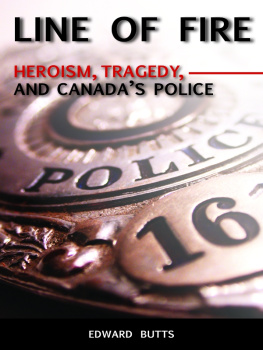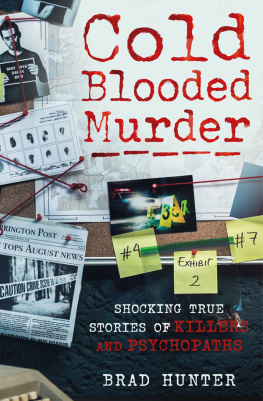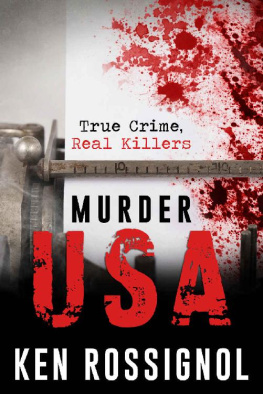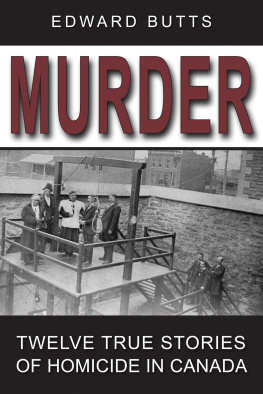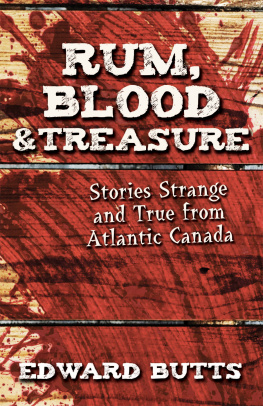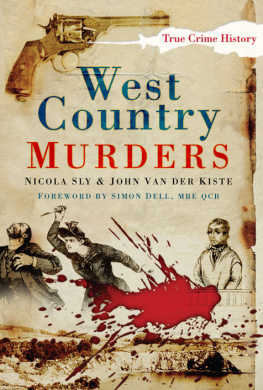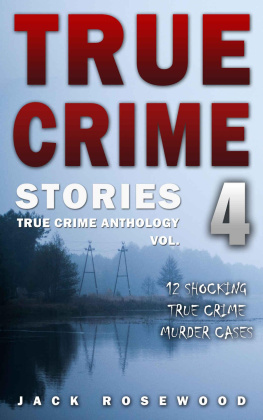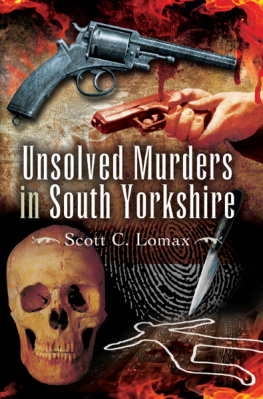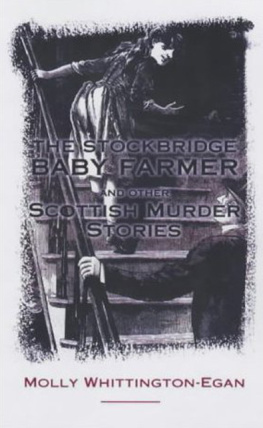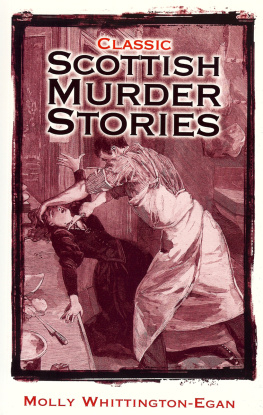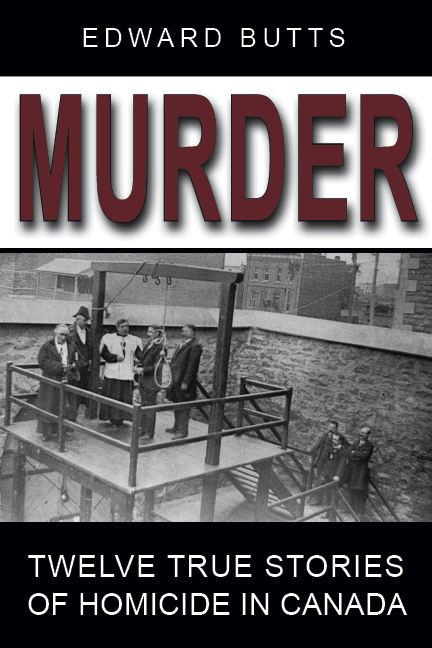MURDER
EDWARD BUTTS
MURDER
TWELVE TRUE STORIES OF HOMICIDE IN CANADA

DUNDURN PRESS
TORONTO
Copyright Edward Butts, 2011
All rights reserved. No part of this publication may be reproduced, stored in a retrieval system, or transmitted in any form or by any means, electronic, mechanical, photocopying, recording, or otherwise (except for brief passages for purposes of review) without the prior permission of Dundurn Press. Permission to photocopy should be requested from Access Copyright.
Project Editor: Michael Carroll
Editor: Nicole Chaplin
Design: Jesse Hooper
Library and Archives Canada Cataloguing in Publication
Butts, Edward, 1951-
Murder : twelve true stories of homicide in
Canada / by Edward Butts.
Includes bibliographical references.
Issued also in an electronic format.
ISBN 978-1-55488-762-0
1. Murder--Canada. I. Title.
HV6535.C3B88 2011 364.15230971 C2010-902693-4

We acknowledge the support of the Canada Council for the Arts and the Ontario Arts Council for our publishing program. We also acknowledge the financial support of the Government of Canada through the Canada Book Fund and Livres Canada Books , and the Government of Ontario through the Ontario Book Publishers Tax Credit program, and the Ontario Media Development Corporation .
Care has been taken to trace the ownership of copyright material used in this book. The author and the publisher welcome any information enabling them to rectify any references or credits in subsequent editions.
J. Kirk Howard, President
Printed and bound in Canada.
www.dundurn.com
Dundurn Press
3 Church Street, Suite 500
Toronto, Ontario, Canada
M5E 1M2
Gazelle Book Services Limited
White Cross Mills
High Town, Lancaster, England
LA1 4XS
Dundurn Press
2250 Military Road
Tonawanda, NY
U.S.A. 14150
For my grandniece, Capree, born January 14, 2010
ACKNOWLEDGEMENTS
I would like to thank all of the people at Dundurn Press who were of assistance to me while I was working on this book, especially Michael Carroll and Nicole Chaplin. I would also like to express my gratitude to the following institutions and individuals: Library & Archives Canada, the Royal BC Museum, the Glenbow Institute, the Provincial Archives of Alberta, the Cobourg, Ontario, Public Library, The Beaton Institute of Cape Breton, the Rooms Archives of Newfoundland, Sgt. Douglas Pflug of the Guelph, Ontario, Police Services, Kelly-Ann Turkington, Diane Lamourieux, Ian Kennedy, Melanie Tucker, Susan Kooyman, Katie Roth, Chris Hamilton, John Draper, Anne MacNeil, and as always the staff of the Guelph, Ontario Public Library.
INTRODUCTION
Murder is always a mistake.
One should never do anything that one cannot talk about after dinner.
OSCAR WILDE
There is a strong element of pragmatism in Oscar Wildes famous witticism on the dark subject of murder. Once the foul deed has been committed, it must be cloaked in secrecy to avoid punishment. Even though some countries, like Canada, no longer have capital punishment, there is always the prospect of a long prison term.
Volumes have been written by psychiatrists, criminologists, historians, and numerous experts about why people commit murder. People kill out of greed, jealousy, revenge, and ambition; or to get rid of an inconvenient spouse or relative. Sometimes people kill in blind rage, or while under the influence of alcohol or narcotics. Murder can also happen when another crime, like armed robbery, goes terribly wrong.
People are morbidly fascinated by murder. Murder has been a key element in literature since the biblical story of Cain and Abel. It is also the central theme of Hamlet and Macbeth , two of Shakespeares greatest dramas. In the modern age, murder stories have been the bread and butter of the movie and television industries. Some true-life murder stories, like those of Jack the Ripper in England and Lizzie Borden in the United States, have become legendary.
Murder has always haunted Canadian society. Between Confederation in 1867 and the last instance of capital punishment in 1963, more than 700 people convicted of murder were hanged in Canadian jails. This long list of documented executions does not include those from colonial times, nor does it cover convicted murderers whose sentences were commuted or murderers who were never caught. Unfortunately, sometimes murderers get away with it.
Some Canadian murderers acted impulsively. Others cold-heartedly planned their crimes, taking every possible precaution to avoid arrest. Their victims ranged from family members to total strangers. Their bloody deeds made headline news. Then, in typical Canadian fashion, they were forgotten.
No Canadian murder has ever gained such lasting international notoriety as those of the mysterious Ripper or the enigmatic Miss Borden. Even the names Clifford Olsen, Marc Lepine, Paul Bernardo, and Robert Pickton whose brutal multiple homicides shocked and sickened the Canadian people, are not familiar to many people beyond our borders. For that, the majority of Canadians are probably grateful: murder does not enhance the national image.
In London, England, tourists can go on Jack the Ripper tours of Whitechapel, where the killer stalked his human prey. And the Lizzie Borden House in Fall River, Massachusetts, is a bed & breakfast and museum. Tourists to Canada wont find similar attractions to titillate their morbid curiosity, though. At best, there might be a historic plaque marking the site of a noteworthy murder, such as the one on the Gibraltar Point Lighthouse on Toronto Island. And, though there have been a few plays and made-for-TV movies have been based on true Canadian murder cases, there have been no major feature films like The Boston Strangler (American, 1968) starring Tony Curtis and Henry Fonda, or 10 Rillington Place (British, 1971) starring Richard Attenborough and John Hurt. It isnt because Canada doesnt have intriguing, true tales of murder. It does. The following chapters are but a small sampling of homicide in our country before 1950. The crimes they describe were heinous; not at all the sort of thing one could do, and then talk about after dinner.
1.
MURDER AT GIBRALTAR POINT:
THE LIGHTHOUSE KEEPER
John Paul Radelmllers death is one of Torontos oldest murder mysteries. It is well-known among Toronto history buffs that the first keeper of the lighthouse on Toronto Island mysteriously disappeared, allegedly a victim of foul play. But almost nothing has been written about the man himself. In the sketchy accounts that have found their way into print usually stories based on folklore he has been described as an unsociable old recluse, a bootlegger who cheated his customers with watered-down booze, and even a traitor and smuggler during the War of 1812. Most of these accounts dont even get his name right: Radmuller, Rademuller, Raddelmullar, and Randan Muller have all appeared in stories. He took the Oath of Allegiance in York (Toronto) on May 5, 1805, and from that record we know that he was a resident of Markham: Yeoman (farmer) five feet ten inches high blue Eyes & Brown hair Forty two years old.
Thankfully, a series of letters written in Radelmllers own hand has survived, and they provide a concise autobiography. The letters reveal a man who was reasonably well-educated, polite, humble, and quite public-minded. When Radelmller arrived in Canada, hed already lived quite an interesting life as a servant in English royal households.


